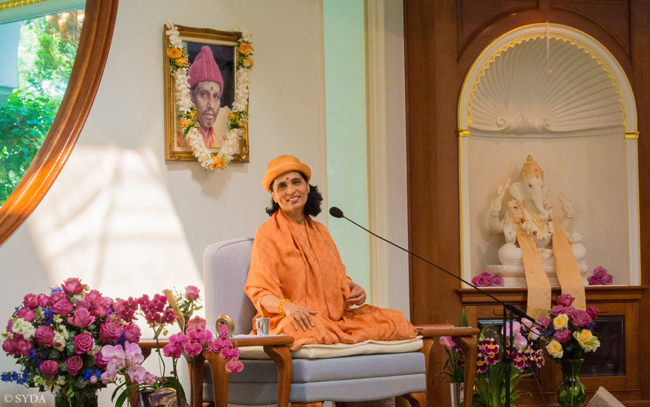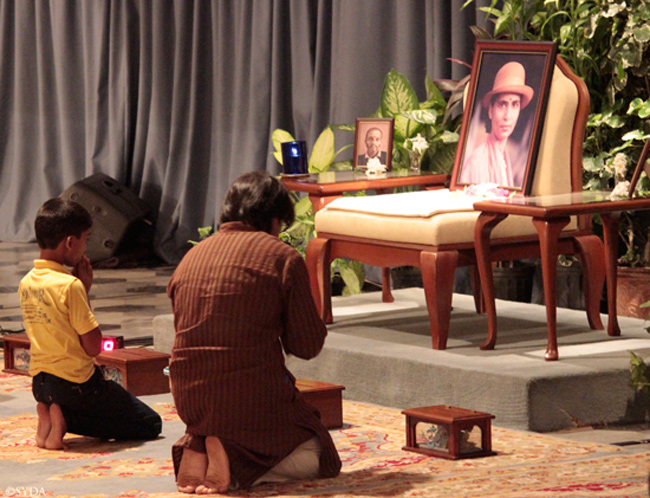Kṛpā kā Jharanā
The Waterfall of Grace
Part VIII
An Account of the Gurupurnima Celebration Satsang
with Gurumayi Chidvilasananda
Shree Muktananda Ashram and Gurudev Siddha Peeth
Saturday, July 12, 2014
by Swami Ishwarananda and Ami Bansal
Kṛpā kā jharanā. The waterfall of Guru’s grace is constant. It is ever-flowing. It flows abundantly and is always there for us to recognize in each moment.
We have taken incredible delight in recalling how grace manifested throughout this momentous celebration of Gurupurnima with Gurumayi.
Although this mahā-satsang is forever etched in the minds and hearts of those who participated in it, we knew we had to record this Account and share it with the rest of the world. And we wanted to do this while the experience is fresh for us. This way, every reader feels included in this satsang and can partake of its sweetness and understand its significance. We have shared the Account chapter by chapter so that the satsang continues throughout the month-long celebration of Gurupurnima.
Gurumayi has always taught the importance of creating the Siddha Yoga legacy and has given ample guidance in how to do so. In light of this, we also wrote the Account of the Gurupurnima satsang as a contribution to this legacy. Now future generations of Siddha Yogis will know how Gurumayi celebrated Gurupurnima 2014 with her devotees in Gurudev Siddha Peeth. They can learn the form and spirit of celebrating this most sacred occasion—how disciples worship and offer gratitude to Shri Guru.
We can best describe the power of the Guru-disciple relationship through these words of the poet-saint Kabir. After receiving shaktipat from his Guru, Ramananda, he sang:
Gagan manḍal mẽ varshā hoyī
ami ke kunḍa ulaṭ gaye rī.
Sadguru mile sāre dukha bisare,
Antara ke paṭkhul gaye rī.
In the inner space of the sahasrāra, the divine music is resounding. Because of that divine sound, nectar is released. I have become ecstatic from drinking it continuously. I have found the Sadguru. My inner divinity has been revealed to me, and all my pain has vanished.
When we shared with Gurumayi our ideas for this Account, along with some possible titles, Gurumayi was very pleased, saying: “Yes, let’s always bathe in the purifying knowledge of the Guru’s grace.” And she gave us the title Kṛpā kā Jharanā, “The Waterfall of Grace”—which conveys the Guru’s blessings as well as the Guru’s knowledge, Shri Gurujñāna.
In the Indian tradition, the goddess Sarasvati—the goddess of all forms of knowledge—is always depicted next to a flowing river or stream.  Her name, Sarasvati, also signifies a flowing body of pure water. Shri Gurujñāna is ever-flowing, and it purifies all who receive and embrace it. The Guru’s sacred knowledge purifies and transforms the lives of seekers. As the scriptures say, jñānam annam, “Knowledge is food” (Śiva Sūtra 2.9).
Her name, Sarasvati, also signifies a flowing body of pure water. Shri Gurujñāna is ever-flowing, and it purifies all who receive and embrace it. The Guru’s sacred knowledge purifies and transforms the lives of seekers. As the scriptures say, jñānam annam, “Knowledge is food” (Śiva Sūtra 2.9).
After receiving Gurumayi’s title for this Account, Kṛpā kā Jharanā, “The Waterfall of Grace,” we realized that this is why the preparations for the satsang had gone so smoothly. We understood that when the sevites said “Yes!” to Gurumayi’s wish to hold this satsang, they immediately stepped into the waterfall of her grace. The waterfall dissolved all barriers between India and New York. It is the nature of water to find ways to keep flowing forward. In the same way, through the power of grace, all the sevites flowed together easefully and smoothly, as one cohesive unit. Just as the flow of water is undeterred by time or distance, sevites in both locations worked together without any sense of separation. The scriptures say:
asādhya-sādhaka śūramutsāha-bala-samyutam
anukūlakriyāyuktamapramattam vicakśanam
He is a wise person who, through sadhana and the power of his enthusiasm, makes possible that which is impossible. He never neglects to engage himself in austerities and suitable work. He is courageous.
Kulārṇava Tantra, 13.28,
When Ami reflected on this experience of Kṛpā kā Jharanā in preparing for the satsang, she was reminded of a word she has often heard Gurumayi use to describe something that takes place in a natural, spontaneous way: sahaja. In Sanskrit, the word sahaja means “that which arises naturally and effortlessly from the timeless space of the supreme Self.” The actions of a great being are alwayssahaja, as they arise from the state of oneness with the Self.
When Ami shared with Swami Ishwarananda that her experience of the satsang coming together and taking place was sahaja, Swamiji immediately thought of sahaja samādhi, the highest attainment of yoga. One who is in the state of sahaja samādhi lives constantly in the awareness of the Self within and without. Therefore, one’s every word and action arise spontaneously from the Self and are a natural expression of yoga, union with the Self. On the Siddha Yoga path, the goal of Shaktipat Intensives, satsangs, seva, and all of the Siddha Yoga practices—the goal of Siddha Yoga sadhana itself—is sahaja samādhi.
In Gurudev Siddha Peeth, as the Gurupurnima satsang was concluding, everyone was reveling in the profound silence, in the experience of sahaja samādhi. With a grateful heart, Ami stood up to fulfill Gurumayi’s earlier request to speak about Paliwal ji and what an extraordinary sevite he was.
Ami then invited everyone to come for darshan. Darshan is being in the presence of the Guru and experiencing the Guru’s presence in the heart. On the Siddha Yoga path, one of the ways of practicing darshan is to come forward and pranām to the Guru’s seat or pūjā. It is also a tradition to make an offering of dakshinā at this time.
It is also a tradition to make an offering of dakshinā at this time.
Having been in the presence of Gurumayi during the satsang, we had had a clear glimpse of the Self. And now, with our hearts overflowing, we came before Gurumayi’s chair to offer our pranāms and our Gurupurnima dakshinā.





